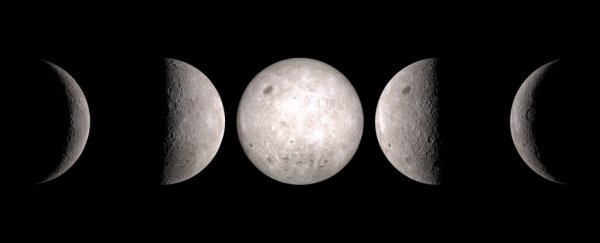Time seems to move faster as we age, but it turns out that maybe the opposite is true: our days on Earth are getting longer over time, and it's all thanks to the Moon's effect on our planet's rotation.
But don't go planning your extra sleep-ins just yet. A new study has traced the relationship between Earth and the Moon back 1.4 billion years, and found that, all the way back then, a day was just over 18 hours.
That means we've gained an extra six hours, give or take, since then - or, on average, a very unnoticeable 0.00001542857 seconds a year.
And the reason is because the Moon is constantly, and ever-so-slightly, moving away from us. 1.4 billion years ago, it was a fair bit closer, and Earth's rotation was faster.
"As the moon moves away, the Earth is like a spinning figure skater who slows down as they stretch their arms out," said geoscientist Stephen Meyers of the University of Wisconsin-Madison.
The team used a technique called astrochronology, which links the geologic record with astronomical theory to reconstruct the history of Earth and the Solar System.
More specifically, they used something called Milankovitch cycles, the changes in Earth's climate caused by changes in its orbit around the Sun, its axial tilt, and its axial precession, or the wobble of Earth's axis towards and away from the Sun.
This results in variations in the amount of solar radiation reaching different latitudes, and these changes in climate are recorded in ancient rock and fossils.
Using astrochronology, scientists are able to study Earth's climate and how it related to other objects in the Solar System, dating back hundreds of millions of years. Changes in the climate due to orbital changes are called orbital forcing.
But going back farther in the geologic record, into the billions of years, is more difficult, because dating techniques such as radioisotope aren't quite precise enough to identify cycles that far back.
Another complication is the chaotic Solar System theory - the idea that, rather than having regular and highly predictable orbits, over time the objects in the Solar System are growing more chaotic.

It's possible to determine how the Solar System might have changed over time by examining the geologic record. This Meyers and colleagues demonstrated last year, when they published a paper showing interactions between Earth and Mars occurred 90 million years ago, based on layers of sediment in a Colorado rock formation.
This, they said, was the first unambiguous evidence of a chaotic Solar System.
But going back farther in time poses more problems. For instance, the Moon is currently moving away from Earth at a rate of 3.82 centimetres (1.5 inches) a year. We know the Moon is 4.5 billion years old - but if we extrapolate back the current rate, the Moon would have been so close to Earth 1.5 billion years ago that it would have been ripped apart by the planet's gravitational forces.
Together with Earth scientist Alberto Malinverno of Columbia University, Meyers developed a system called TimeOptMCMC which combines astronomical theory, geologic data and a statistical approach called Bayesian inversion to help deal with uncertainty.
They applied it to two rock layers, the 1.4 billion-year-old Xiamaling Formation from Northern China and a 55 million-year-old record from Walvis Ridge, in the southern Atlantic Ocean. They found they could calculate the distance between Earth and Moon, the variations in Earth's orbit, and even the length of a day 1.4 billion years ago.
The Earth-Moon distance as reconstructed using TimeOptMCMC for the Xiamaling Formation showed that the Moon was moving away from Earth more slowly in the past - which means the amount of time our day gains per year is growing over time.
This means that recent research that found our days were getting longer by around 0.000018 seconds per year is still valid.
In the future, the researchers want to use their approach to reconstruct the evolution of the Solar System going back billions of years.
"The geologic record is an astronomical observatory for the early Solar System," Meyers said. "We are looking at its pulsing rhythm, preserved in the rock and the history of life."
The team's research has been published in the journal PNAS.
